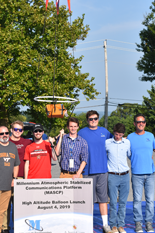News Story
Millennium Engineering Supports New Balloon Payload Projects

During the summer of 2019, aerospace engineering junior Jonathan Molter interned at Millennium Engineering. As a summer intern, Molter and his team members were tasked with developing three new high-altitude balloon payloads—atmospheric sensing, a reaction momentum wheel, and long range Wi-Fi system for data transfer—that could provide capabilities similar to more sophisticated systems, like those used by NASA or the DOD, at a fraction of the cost. The new payloads would then be tested and flown through the University of Maryland Balloon Payload Program (BPP).
The Balloon Payload Program at Maryland, under faculty advisor Dr. Mary Bowden, provides students access to “near-space” through the use of weather balloons that lift small payloads to the edge of the atmosphere (85,000-100,000 ft. altitude). Since 2003, the program has launched more than 90 balloons.
Developing the new payloads at Millennium was the idea of company co-founder and UMD alumni Kerry Wisnosky (aerospace engineering, ’86). As a longtime supporter of the university and an A. James Clark School of Engineering Board of Visitors member, Wisnosky is always looking for more ways to engage students in projects that are practical and provide hands-on experience that compliments their college education.
“One of the great things about these high-altitude balloon projects is that they [the students] really have to go through the entire systems engineering process,” explained Wisnosky. “Whether you’re building a rocket or a satellite, it’s a very similar kind of process. And in the balloon program, it’s repeatable, so that is hugely beneficial thing that is going to permeate through these student’s experiences through the rest of their career.”
Molter has been involved with the Balloon Payload Program since his freshman year and is currently an undergraduate researcher primarily working on tracking and operations. During his internship at Millennium, he not only expanded his understanding of risk analysis and documentation through the process, but he found working with individuals from different disciplines and backgrounds to “be highly rewarding because everyone generated different ideas in different ways and we were able to learn quite a bit from one another.”
This spirit of collaboration is part of why Wisnosky enjoys working with the students and UMD, but he also thinks that the available resources on campus really help drive the ability to address challenging projects over short time periods.
“One of the things I like about working with the University of Maryland, other than the obvious of being an alumni, is the really good facilities there,” said Wisnosky. “There’s a lot of really important test facilities at the school that make it really effective and efficient to help develop a summer intern project in just over three months.”
The Millennium payloads were successfully launched on August 4, and again in the early fall after modifications were made to address an electronics cooling issue.
The new long-range, onboard Wi-Fi downlink system allowed students for the first time to collect payload data and imagery in real-time. Prior to this, data could only be collected once the balloon landed, and if the team couldn’t recover the balloon, they also lost the data.
In addition to the onboard Wi-Fi system, the intern team also developed a reaction wheel that would allow them to have better control over the balloon’s payload in flight.
“When you launch a balloon payload, you’re at the mercy of the winds, the temperature, the pressure, so you have no control over your payload, or the equipment onboard,” said Wisnosky. “But with the momentum wheel, it’s like being on a gimbal, so you can control where you want to be pointing. This will enable the team to design experiments where you can point in a specific direction, or even to be able to observe other onboard payloads.”
The university will be allowed to keep the payloads designed at Millennium, which will help expand opportunities for future experiments.
Molter and his team members, including sophomore Natalie Condzal, already have plans to improve on the payloads for future flights. Condzal is working on a payload dubbed DownLink, based on the original Millennium Wi-Fi design to enable live stream of video on future flights. They are also looking to add an automatic antennae pointing system that would improve signal quality.
The Balloon Payload Program will be launching their 100th balloon in spring of 2020! You can follow the team on Twitter at @UMDNearspace.
Published December 19, 2019









